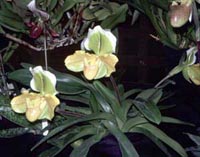Resource Library
Plant of the Week: Orchid, Lady Slipper
The University of Arkansas System Division of Agriculture does not promote, support or recommend plants featured in "Plant of the Week." Please consult your local Extension office for plants suitable for your region.
Plant of the Week
Lady Slipper Orchid
Latin: Paphiopedilum hybrids

People with a deep passion for their plant group often strike those who lack that
intense feeling as somewhat strange. The most passionate, and therefore the strangest
group of plant people, are the orchid people. The psychoanalyst would probably classify
their fervor as a severe obsessive-compulsive disorder, but to orchid people its simply
called "orchid fever."
This condition has been wonderfully chronicled in a new book by Eric Hansen called
Orchid Fever, a horticultural tale of love, lust and lunacy, published this year by Pantheon Books.
Hansen introduces us to orchid people around the world whose efforts to pursue their
passion -- sometimes as a hobby, or as a scientist or a business -- is being threatened
by what the orchid people consider an overzealous and woefully unenlightened international
organization called CITES. This United Nations umbrella organization, Convention on
International Trade in Endangered Species of Wild Fauna and Flora, is based in Geneva
and has a mandate to stop the trade on anything they put on their Appendix I list.
The original intent of the legislation was to restrict trade in elephant tusks, rhino
horns and tiger testicles, so a provision was added restricting trade not only in
living organisms but also all "parts" of said organism.
This makes sense when dealing with rhino horns because to get the horn you’ve got
to kill the rhinoceros. But for orchids, the great majority of which seem to have
been placed on the Rare and Endangered list, this restriction prevents collection
of seed pods so that rare plants can be brought into cultivation.
Each orchid seed pod typically contains up to a million seeds. The technology for
bringing these naked orchid embryos to life has been perfected so a single pod could
easily supply the world with all of the rare orchids the market should demand. But
because it is impossible to legally import seed pods, the price of the species on
the Appendix I list are artificially inflated, often to thousands of dollars per plant.
The regulations are so absurd it is even illegal to collect rare plants that are
being killed in tropical logging operations. The CITES rules, at least according to
Hansen, are designed to completely thwart any efforts to use wild flora for commercial
gain and to only allow a few select institutions such as botanists from Kew Gardens
in London to gain access to the plants. The artificial barriers lead to high prices
for the plants. When this is combined with the passion of serious collectors, people
afflicted with orchid fever sometimes become orchid smugglers.
Paphiopedilum (pronounced "paf-ee-oh-pedilum") hybrids, now available from Florida and California
growers during the late winter and spring, are harder to keep alive than their epiphytic
cousins, the Dendrobiums.
The lady slipper orchids are a group of terrestrial orchids from the jungles of southeastern
Asia, centered particularly in Thailand, Burma and Borneo. The leaves of this group
are two-ranked from the ground, leathery, usually about 10 inches long and shaped
somewhat like an amaryllis leaf. From the center whorl of leaves, the flower scape
emerges with from one to three flowers that may be as much as 5 inches across. The
flowers have an erect hood at the top, a pair of arching petals like a handlebar moustache
and then an inflated slipper-like pouch at the base.
The array of color combinations, with striping and spotting, is limitless, but flowers
typically are in shades of yellow, green, pink or combinations of these.
The plants should have a well drained, coarse organic potting mix and should be kept
uniformly moist throughout the year, with special care not to get excessive water
into the crown of the plant. Temperatures during the summer should be kept as cool
as possible; but during the winter nights, temperatures should be kept above 60 degrees
for most of the hybrids. Most orchid hobbyists have either a greenhouse or use banks
of artificial lights to give the plants the care they need.
By: Gerald Klingaman, retired
Extension Horticulturist - Ornamentals
Extension News - June 16, 2000
The University of Arkansas System Division of Agriculture does not maintain lists of retail outlets where these plants can be purchased. Please check your local nursery or other retail outlets to ask about the availability of these plants for your growing area.